Gauge & Scale
0m: The Other Garden Gauge Railroad
Mar 24, 2010


By Ralph Walker |
Author
Bio
I planned to run an 0m train in the background, with the same trains running in the foreground in G scale, but my plans changed. I decided to sell my collection of 0m trains, but want to describe them while I still have them in hand to photograph.
|
Nothing has been written on LSOL about the Swiss 0m gauge. It is not 'large' scale, but it isn't small either, being 1:45. It is, however, a garden gauge and the equipment is weatherproof, just like LGB. I planned to run an 0m train in the background, with the same trains running in the foreground in G scale, but my plans changed. I decided to sell my collection of 0m trains, but want to describe them while I still have them in hand to photograph. 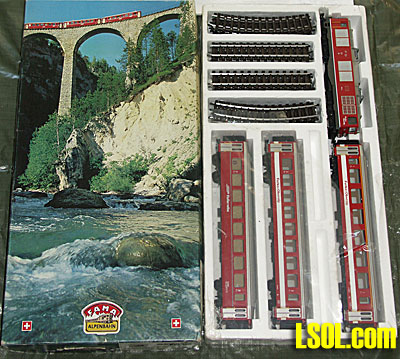
We spell "O" gauge with the letter O, whereas the Europeans use the original designation of zero. It would follow that we would name the meter gauge "Om" rather than "0m", but since this gauge is practically unknown in the US I am using the numeral zero, as the Europeans do. LGB's Swiss offerings are primarily trains from the Rhaetian Railway (RhB), with a few other trains from the two railways that connect to the RhB to form the Glacier Express (GE). These were the Furka-Oberalp-Bahn (FO) and Brig-Visp-Zermatt-Bahn (BVZ). Since 2003 these two lines have been merged into the Matterhorn-Gotthard-Bahn (MGB). For the most part these passenger trains are red. This is an intentional scheme to project a single identity to the several lines that operate on this route. The Glacier Express is basically a cross country route from Zermatt in the south to St. Moritz in the east. The first half, operated by the MGB, is combination rack/traction, the second half, operated by the RhB, although quite steep in places, is all traction. All Swiss railways are electrified and have been for many years. The route of the GE was electrified about 1930, so diesel-electric is only used for switching, maintenance, tourist runs and during power failures. But diesel electric locomotives are easier and cheaper to model.
The only line of 0m trains of which I am aware which were officially imported into the US were the FAMA AlpenBahn 'Basic Set' and 'Glacier Express', both of which included an HGm 4/4 diesel-electric locomotive of the FO. In Swiss nomenclature, 'H' designates a rack locomotive, 'G' is narrow gauge and 'm' is internal combustion engine. This locomotive models one of two purchased in 1967, and is definitely not appropriate for passenger service. It did have an interesting history in that it was pressed into service after a devastating landslide at Brig in 1991 destroyed much of the electrified infrastructure, but it is a stretch to market this locomotive as part of the 'Glacier Express', and I doubt that it ever actually crossed the RhB's Landwasser Viaduct, as shown on the carton.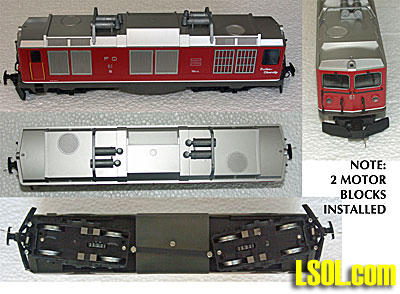
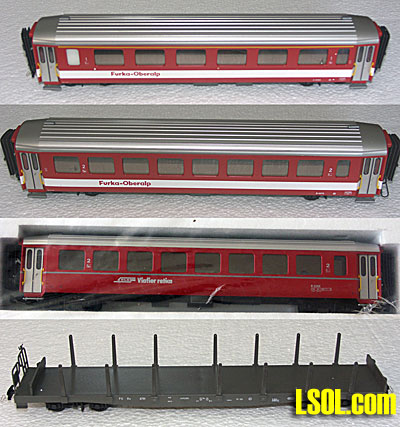
There were a number of other manufacturers of this scale and they offered a full range of models, including electric. 0m equipment is expensive even though it has a small following, and the people you would be competing with if you modelled this scale are Germans, Swiss and English, people who are used to paying way more than things are worth. It is quite easy to spend $2000 for a passenger car, though the more common ones sell for $75-$150. It is therefore not practical for an American to have a 0m scale railroad; but it would be sensible and attractive to include some 0m in the background of a G scale railroad, especially if you are a fan of the red southern Switzerland narrow gauge lines. In 2001 the SBB (Swiss National Railway) formed a foundation named SBB Historic. In 2004 they purchased a well-established private model train museum in Interlaken, the Eisenbahn Treff-Punkt (train meeting point). They ran it until 2008 when they sold the building and apparently the contents. It is now a soft drink distribution warehouse.
The claim to fame of the museum had been an extensive (to my knowledge the ONLY extensive) layout of 0m gauge Swiss trains. The layout felt much like scale-model O railroads, though the track is 2-rail. The layout ran through several large rooms and passed through assorted mountainous scenes. I visited it many times and was greatly disappointed (and appalled) at its disposal. I have been unable to find any information on the WWW about the fate of the museum and its collection, which also included magnificent 1:10 Swiss models. Fortunately I made plenty of photos and videos of the museum, so I am including 3 stills of the 0m display below.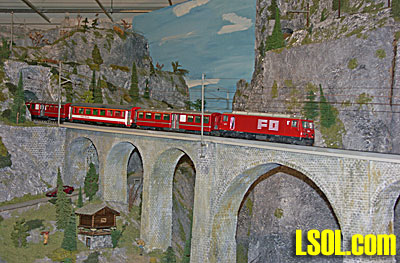
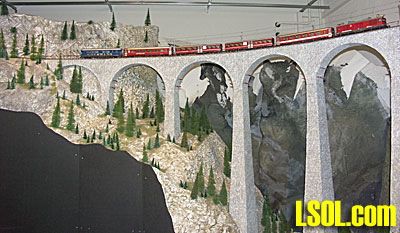
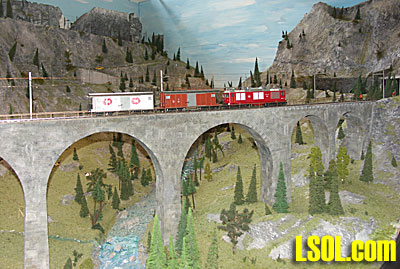
If you'd like to see some unedited footage of these trains in action, please visit WWW.ZWEISIMMEN.COM (my personal website). At that same location you can download a PDF copy of the FAMA instructions, which includes charts of climbing capability and the entire track program.Even though this scale is unknown outside of Europe, it is a pleasing and sensible scale, especially for Europeans who do not have the luxury of large dwellings and large yards. The scale is basically Lionel, being 1:45, but it is a meter gauge running on 22.5mm track, or half the size of LGB rolling stock and G track. This brings up an interesting question to which I do not have the answer: Since our S gauge track is .883" or 22.4mm, is it possible to run 0m trains on S track? If it were possible one could indeed lay stainless steel S gauge track outdoors for these trains. The trains were primarily built in Switzerland and have a good reputation for strength and longevity. The museum display ran from May until October every year so the equipment must have been pretty reliable. They are claimed to be weatherproof, just like LGB, but the advice in the instructions is to cover them if left outside. The AlpenBahn product line by FAMA uses plated steel track. 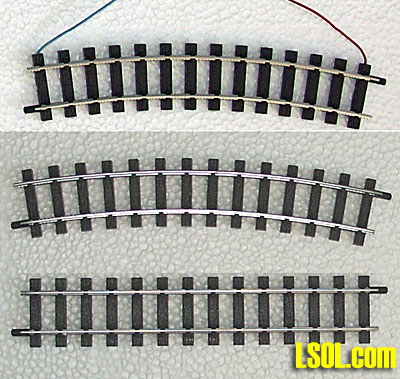
This is necessary to take advantage of the extra adhesion from 4 magnets mounted under each motor block. This allows for climbing steep grades. You can add a second motor block, along with 4 more magnets, for even more climbing ability. And each motor block is equipped with a rack drive. (See the photo of the underside of the locomotive, above). If you can find some plastic rack sections a locomotive equipped with two motor blocks and 2 rack drives will climb in excess of a 30% grade. It would be fun to try this as the instructions state that a single motor block with the locomotive pulling a single passenger car can climb 30%. I do not have real experience with this since I never used my trains on a railroad. I did however attach some track to a sheet of plywood which I tilted, in order to witness this climbing action, and it was most impressive. As a side note, I attended a model expo in southern Germany in 2006 where one of the exhibitors was demonstrating his system of magnets for use on an LGB RhB locomotive for the same purpose. Magnets were attached to the underside of the locomotive and were attracted to sections of magnets placed between the rails of standard brass track. I regret that I have mislaid the name of the individual who developed this system. Very few LGB locomotives offer rack drive, but the system of magnets is a solution for modelling mountainous terrain. 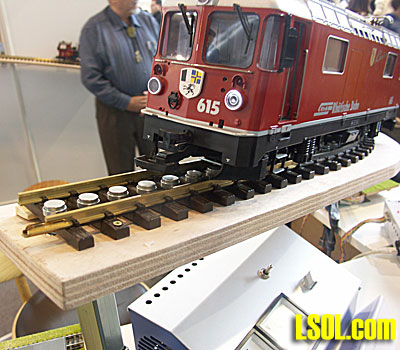
Apparently the biggest names in the 0m business were FAMA, ROCO, KISS and UTZ, though many small studios produced (and may still produce) limited edition rolling stock and trackage. I myself found 3 sets on ebay over the years, being articles 1210 "Glacier Express" and 1110 "Basic Set". Both used the same HGm 4/4 FO diesel electric locomotive. The GE set included a 1st and a 2nd class FO passenger car along with a 2nd class RhB car, while the "Basic" set included the FO 2nd class and two stake flatbed cars. The GE set had sufficient track for an oval 110 mm x 266 mm, while the Basic made an oval of 110 mm x 177 mm. No transformers are included. These trains simply use 18V DC and were imported by MRC, which offered a wide variety of transformers. 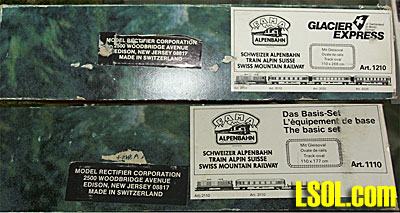
I have observed that the rolling stock is more to scale than similar LGB cars, which are necessarily stubby. A FAMA passenger car will have the correct 9 windows where the LGB counterpart will have 7. Other than this observation, I do not know how close these are to scale. Having ridden on this line at least 100 times I will say that the models look correct to me. They are not highly detailed and they have no interiors, but they do have rubber bellows and are executed to typical high Swiss standards. In the photo below please note the wire couplers. These are calibrated to break away if you attempt to climb too steep a grade while pulling too many cars. 
I know little more about 0m than I have written here, but perhaps some other members have these trains or will become interested in them, and some interesting discussions will ensue. Just as we use smaller scale buildings to add perspective to backgrounds, perhaps 0m could enhance a G scale railroad.
| 0m scale |
| Wow, that answers some questions I have had in the past, I saw photos of a Swiss layout and I couldn?t place the scale, or manufacture. It was obvious that it was smaller than G scale and gauge 1 but certainly bigger than O gauge. Thanks for the article. I thought it was tough to get houses in 1/29th scale I bet it is even tougher in 1/45th scale. |
| Glenn Habrial - 03/24/2010 - 07:32 |
| S guage track |
| I just built a module in HO and HOn30 (N gauge track) and discovered that comercial track in those gauges is slightly over gauge. Also years ago I measured some Aristo track and discovered that it is slightly over gauge too. So if S gauge track follws this trend then it should work fine for 0m gauge |
| David A. Maynard - 03/25/2010 - 12:54 |
Top of Page
|



